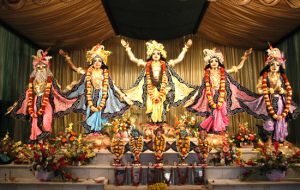Japa
“Japa” means “chanting.” In spiritual context, the japa means “private chanting.” While one may chant nicely and loudly during temple kirtans or outside chanting, per tradition, one must chant the mahamantra privately. Chanting privately will help one develop personal love for Krsna. Not only Gaudiya Vaisnavas accept the notion of japa, but various Hindu groups, Buddhists, and Christians have their own renditions of chanting japa.

JAPA BEAD STRUCTURE:
In order to do this, a rosary set of one-hundred-nine beats is used. The beads, known as the mala (mālā), consist of one-hundred-eight beads known as the chanting beads. The remaining one bead, the head bead, is known as the Krsna bead.
HOW TO CHANT JAPA:
1) One would place the loop of beads handing around the middle finger. The thumb will act as the counter. Place the thumb on the first bead adjacent to the Krsna bead.
2) When beginning japa, one will chant the Panca Tattva mahamantra on the first bead.
3) The thumb will push (or pull) the bead away from the head bead or the Krsna bead. For the remainder of the beads, until reaching the other end.
4) Completion of the chanting on every bead, except for the Krsna bead, is known as a round. Complete the first round by chanting the Panca Tattva mahamantra.(jaya) sri-Krishna-Caitanya prabhu Nityananda
sri-Advaita Gadadhara Srivasadi-Gaura-bhakta-vrinda
5) To do the next round, one may not cross the Krsna bead. Therefore, one may do the following.
a. Change the direction. That is, if you were you pulling beads for the first round, then you push beads away for the second round.
b. Flip the beads in such a way that you do not use your index finger and you continue chanting in the same direction. (i.e. flipping the orientation of the beads will allow one to keep the direction.. keep pulling beads towards, or pushing beads away).
sri-advaita gadadhara srivasadi-gaura-bhakta-vrinda
Sri Caitanya Mahaprabhu is always accompanied by His plenary expansion Sri Nityananda Prabhu, His incarnation Sri Advaita Prabhu, His internal potency Sri Gadadhara Prabhu, and His marginal potency Srivasa Prabhu. He is in the midst of them as the Supreme Personality of Godhead. One should know that Sri Caitanya Mahaprabhu is always accompanied by these other tattvas. Therefore our obeisances to Sri Caitanya Mahaprabhu are complete when we say, sri-krishna-caitanya prabhu nityananda sri-advaita gadadhara srivasadi-gaura-bhakta-vrinda. As preachers of the Krishna consciousness movement, we first offer our obeisances to Sri Caitanya Mahaprabhu by chanting this Panca-tattva mantra; then we say,
Hare Krishna, Hare Krishna, Krishna Krishna, Hare Hare/ Hare Rama, Hare Rama, Rama Rama, Hare Hare. There are ten offenses in the chanting of the Hare Krishna maha-mantra, but these are not considered in the chanting of the Pancatattva mantra, namely, sri-krishna-caitanya prabhu nityananda sri-advaita gadadhara srivasadi-gaura-bhaktavrinda. Sri Caitanya Mahaprabhu is known as maha-vadanyavatara, the most magnanimous incarnation, for He does not consider the offenses of the fallen souls. Thus to derive the full benefit of the chanting of the maha-mantra (Hare Krishna, Hare Krishna, Krishna Krishna, Hare Hare/ Hare Rama, Hare Rama, Rama Rama, Hare Hare), we must first take shelter of Sri Caitanya Mahaprabhu, learn the Panca-tattva mantra, and then chant the Hare Krishna maha-mantra. That will be very effective.










